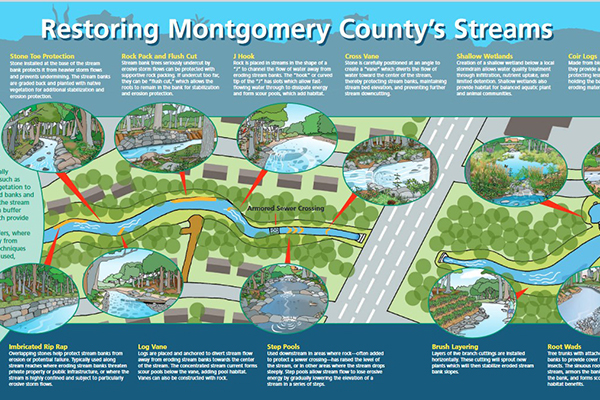Stream Restoration
- Restoration Types & Techniques
- Find a Restoration Project
- Watershed Planning
Watch the "All About Stream Restoration" Video
All About Stream Restoration Video
Todo sobre la RESTAURACIÓN DE RIOS y ARROYOS Vídeo
What is stream restoration? What problem can it solve?
The Problem: Stormwater, Erosion, and Sedimentation
In urban areas, like Montgomery County, rain and snowmelt run across streets, sidewalks, and rooftops, rather than soaking into the ground. This fast-moving, excess water harms our waterways, tearing away the sides of our streams, causing erosion.
The erosion is hard on the trees lining the banks, often causing them to prematurely fall into the stream. Erosion can also be harmful to public infrastructure (such as exposing a sewer pipe) and private property (such as a backyard in danger of eroding away into a stream).
Sediment (soil and dirt) from erosion is also one of the most prevalent pollutant sources in Montgomery County.
Sediment creates a lot of problems for plants and animals in the water:
- It makes the water cloudy. Cloudy water keeps sunlight from reaching aquatic plants, limiting photosynthesis. It also makes it harder for stream critters to hunt for food.
- It reduces the amount of oxygen in the water and makes it difficult for aquatic bugs, fish, and other stream critters to breathe. The sediment in the water can literally clog gills.
- It can increase water temperature. In the same way that we as humans can only live in certain temperatures, high temperature water can be fatal to many fish and other critters.
- It destroys habitat. Many aquatic critters live in the nooks and crannies between rocks and under logs. When a stream becomes filled with sediment, these spaces also get filled in, leaving critters with nowhere to live.
Sediment also impacts our drinking water. All of Montgomery County drinking water comes from our local rivers and reservoirs. Cloudy, sediment laden water requires additional filtration and treatment, increasing costs for treatment and ultimately for our residents.
Stream Restoration in Montgomery County
Stream restoration is a set of techniques or methods the County uses to protect adjacent properties and public infrastructure by reducing stream bank erosion, minimizing the down-cutting of stream bed, and restoring aquatic ecosystems (natural stream system).
Restoration techniques typically use natural materials such as rock, logs, and native plants to help slow down stormwater flow and restore the natural meander of curve pattern found in stable streams. They are usually done in larger scale projects utilizing large equipment to mobilize plants and rocks.
Download Restoring Montgomery County's Stream Poster (PDF)Stream Restoration Techniques
Techniques Using Plants
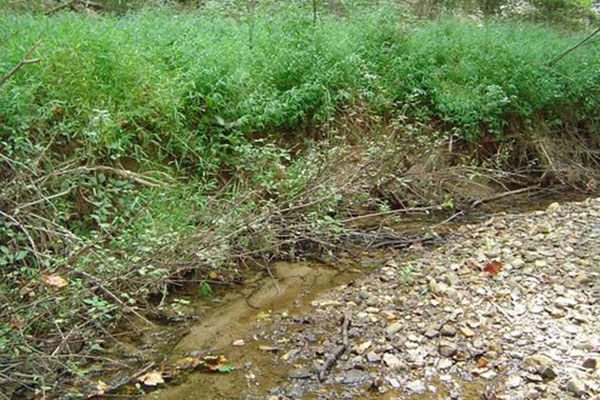 Brush Layering
Brush Layering
Layers of live branch cuttings are placed horizontally along the stream. New plants will sprout from the live branches and the roots will hold the soil down and prevent erosion.
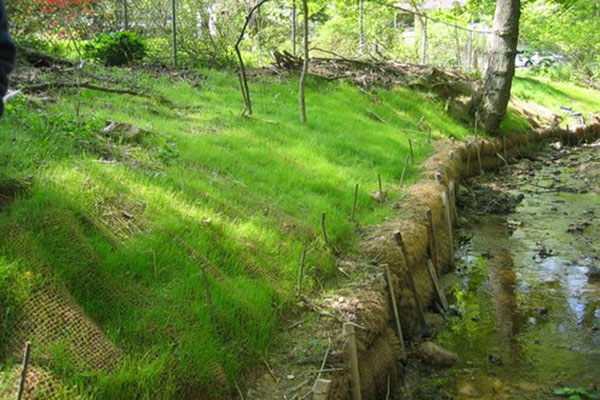 Coir Logs
Coir Logs
Heavy mesh netting made from coconut fibers, used to hold soil in place and help plants grow, reduce weeds, and retain water. They naturally breakdown over time and become part of the soil.
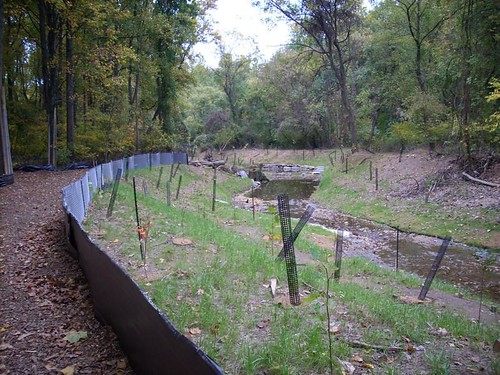 Grading and Planting
Grading and Planting
Steep stream banks are graded into a series of gently sloping steps. During large rain storms, the stream has more room for water to flow and decrease the speed of the flow. In addition, the plants and vegetation roots help stabilize the banks and hold them in place.
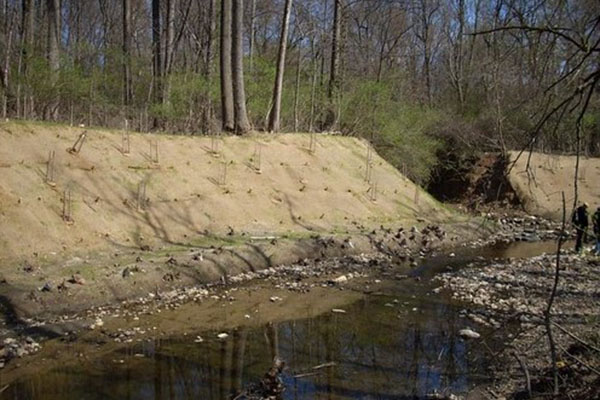 Mulch Planting
Mulch Planting
Lengths of stream bank are planted with plants to stabilize the banks and hold soil in place through the roots of the plant.
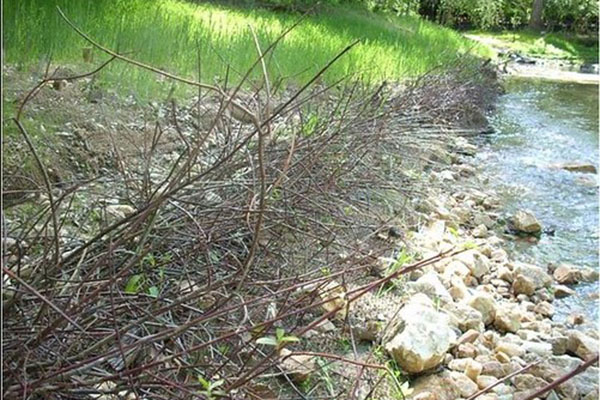 Root Wads
Root Wads
Tree stumps with attached roots are anchored in stream banks with roots facing the streams to slow down flow and provide habitat for fish, amphibians, and aquatic insects.
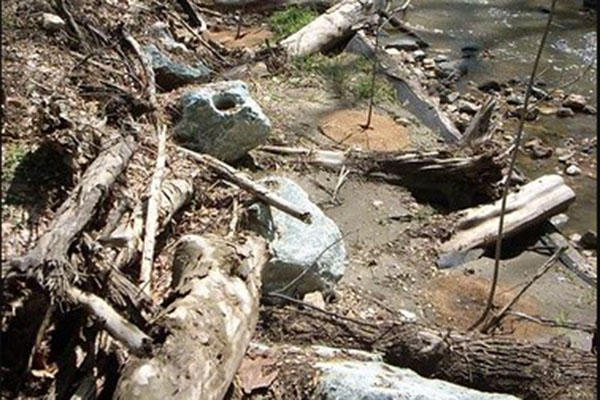 Woody Debris
Woody Debris
Woody debris includes logs and woody material, which can be used to provide spaces where fish can live and reproduce. Large tree limbs and woody materials are anchored along stream banks to reduce erosion and to buttress terraces and pools.
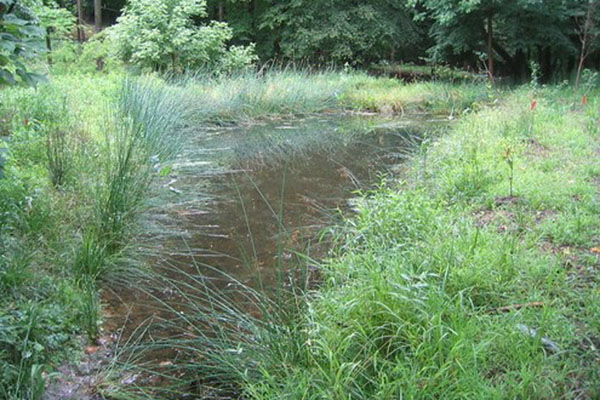 Shallow Wetlands
Shallow Wetlands
A marshland-like environment is created below a storm drain outfall to allow treatment for the stormwater before it reaches the stream. It also provides for aquatic plant and animals.
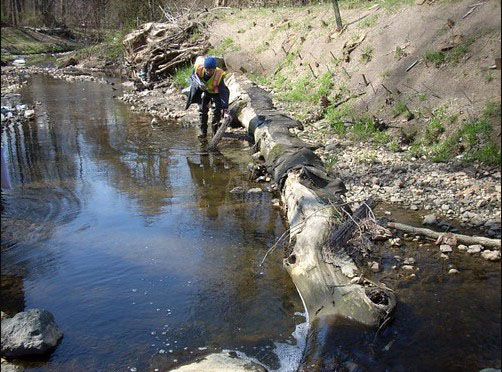 Log Vane
Log Vane
Logs are placed and anchored to direct stream flow away from eroding stream banks towards the center of the stream. The concentrated stream current forms small pools (scour pools) below the vane where aquatic creatures can live.
Techniques Using Rocks
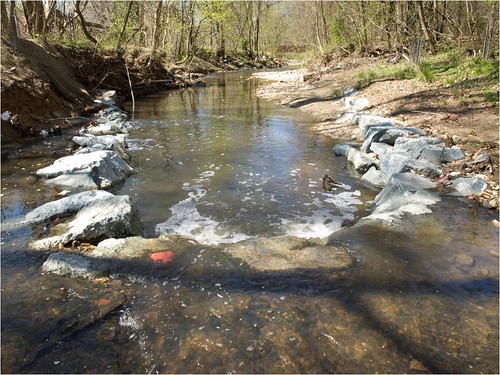 Cross Vane
Cross Vane
Stones are placed in streams in the shape of a “C” or a “V” to direct water towards the center of the stream away from the stream bank and reduce erosion.
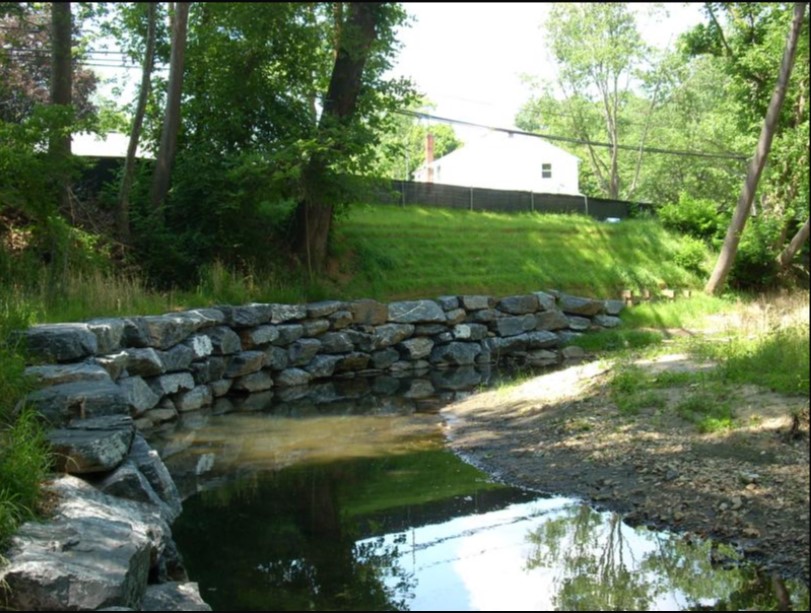 Imbricated Rip Rap
Imbricated Rip Rap
Stones are stacked together forming a wall or slope to prevent soil from being washed away into the stream during heavy rain storms. This is typically used in areas where erosion is severe or near private property.
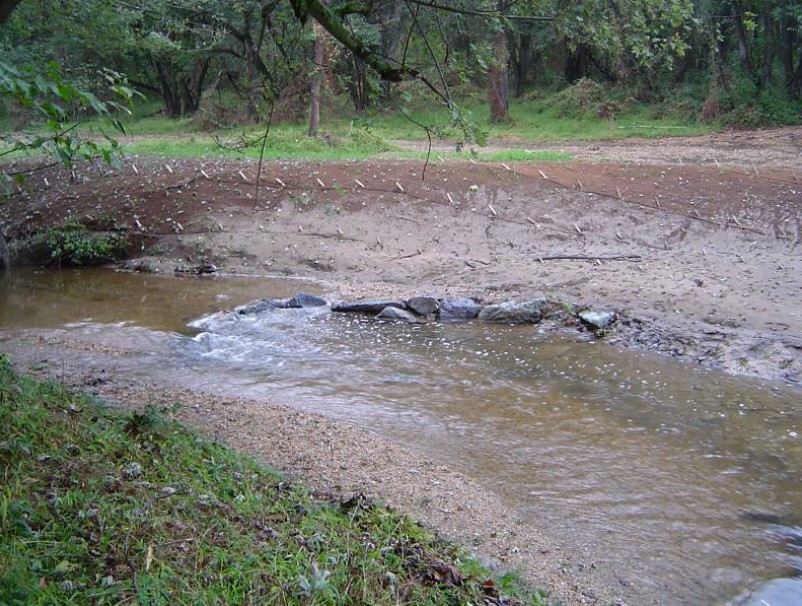 J Hook
J Hook
Rocks are placed in streams in the shape of a “J” to channel the flow of water away from eroding stream banks. The “hook” or curved tip of the “J” has slots for fast-flowing water to pass through and creates small pools (scour pools) where aquatic creatures can live.
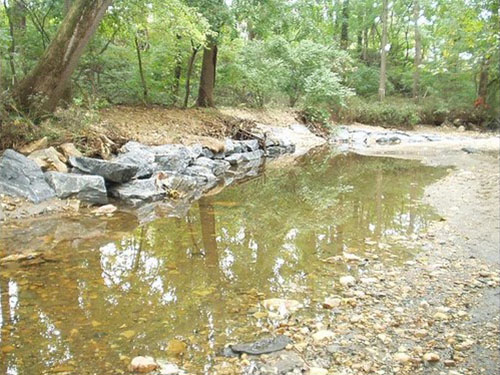 Rock Pack and Flush Cut
Rock Pack and Flush Cut
Trees along the stream bank that are damaged by runoff can be protected with supportive rock packing. If the tree is beyond recovery, it can be cut down (Flush Cut) leaving the trunk to help hold soil in place.
 Step Pools
Step Pools
A series of pools built with rocks that mimic staircase steps to slow down stream flow. This is often used to protect utilities such as sewer crossings, etc.
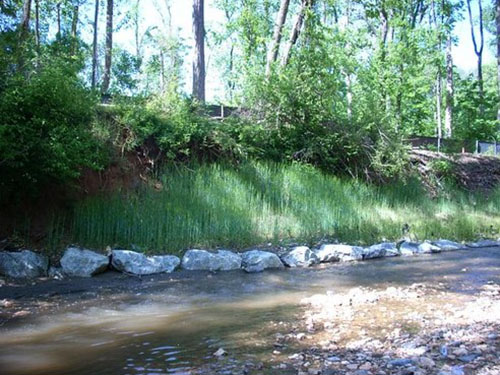 Stone Toe Protection
Stone Toe Protection
Large stones are placed at the base of the stream bank to prevent fast moving stormwater runoff from wearing away and destroying the stream bank. The stream banks can also be carved back to a gentler slope where native plants are planted to hold the soil in place.
Before & After/ Stream Restorations
See some of our before & after photos of projects DEP completed.
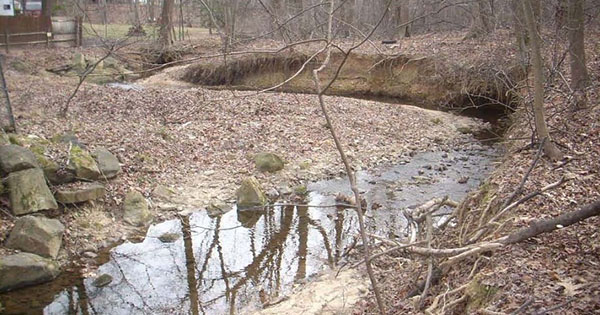
Hollywood Branch - Before
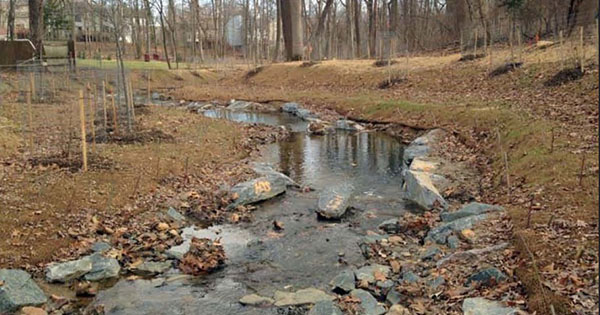
Hollywood Branch - After
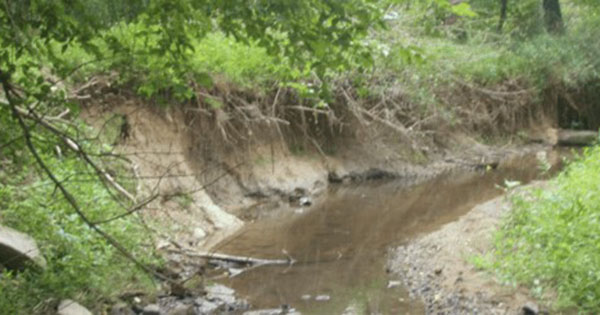
Woodlawn - Before
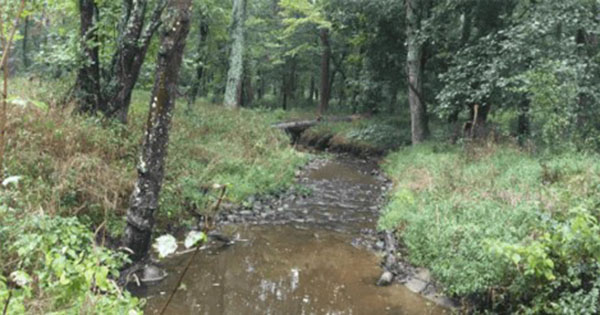
Woodlawn - After
Quick Links:
Frequently Asked Questions
Is stream restoration the only solution?
Stream restoration is only part of the solution. A well-rounded stormwater management program to improve water quality includes stream restorations, tree plantings, tree boxes, and stormwater ponds, among other practices. We use all of these practices to reduce storm flows, reduce erosion and sedimentation, and keep pollutants out of our streams.
Learn more about our various stormwater management programs here: Types of Stormwater Management Facilities
Does stream restoration address flooding?
Right now, our stream restoration projects do not address flooding. They are not intended to address flooding conditions caused by stormwater infrastructure that wasn’t built to handle the increased intensity and frequency of rainfall events due to climate change. In the future, the comprehensive flood management plan will help us design projects that address both water quality goals and assist with flooding concerns.
Will trees be taken down?
During stream restoration projects, we make every effort to improve growing conditions for trees, reduce impacts to retain trees, prioritize healthy and mature trees for retention, and minimize the number of trees removed. Trees are most often removed because they are likely to fall into the stream and cause further damage or blockage, and because they cannot be avoided to gain access to the stream. In nearly all our projects, we make all efforts to plant twice to three times the number of trees that were removed.
What will a restoration look like during and after construction?
As the project progresses and immediately after project completion, the area around a stream restoration may look barren and sparse. Vegetation will begin to return during the next growing season, but it will take time for newly planted trees and other plants to grow and for you to see a more natural stream. Some severely eroded areas of the stream may still look less natural and be armored with rock. This rock is there to protect the stream banks from further erosion.
Will stream restoration increase non-native invasive plants?
Non-native invasive plants are, by their very nature, difficult to manage. Unfortunately, they are prevalent throughout the county, both as mature plants and hidden in seed banks below ground. We have increased our efforts to combat invasive plants through pre- and post-restoration assessments, but also recognize that our limited resources will not solve the uphill battle that is invasive plant management. We continue to do what we can to combat invasive plants, including planting a greater diversity of trees and planting in higher densities.
How will this project be maintained?
Several mechanisms are in place to ensure the project’s long-term success, including:
- Construction contracts with a one-year warranty on plants and invasive control
- Five-year post-construction monitoring
- Contracts for any needed structural and vegetative repairs, and
- Regular inspections
How will this project impact local wildlife?
DEP makes every effort to reduce the impacts to wildlife. Generally, fish are relocated before construction even begins. While animals like deer, rabbits, birds, frogs, and snakes will have their habitat temporarily disturbed by restoration, they will return as newly planted trees and other plants grow and the stream returns to a more natural state.
Aquatic critters tell us a lot about stream health because they have different tolerance levels to pollution. Critters that can tolerate polluted water can be found in streams regardless of water quality. Meanwhile, critters that cannot tolerate polluted water are generally only found in healthy, clean streams.
Depending on the type of restoration, the time it takes aquatic life to return will vary. Typically, fish will be the first to return to the newly created habitat. In many projects, we’ve found that the fish and insect communities that return to the stream are more diverse; these communities are made up of more pollution-tolerant species.
Due to the way urbanization continues to disturb our environment, we do not expect to see species intolerant to pollution to return to our streams.
What state, federal, and local regulatory agencies review the project?
The agencies that review the project are likely to include, but not limited to:
- Federal Emergency Management Agency (FEMA)
- U.S. Army Corps of Engineers
- Maryland Department of the Environment
- Maryland National Capital Parks and Planning Commission (Montgomery Parks)
- Montgomery County Department of Permitting Services
- Montgomery Soil Conservation District
- Pepco
- Baltimore Gas and Electric
- Washington Gas
- Washington Suburban Sanitary Commission
- Property Owners
